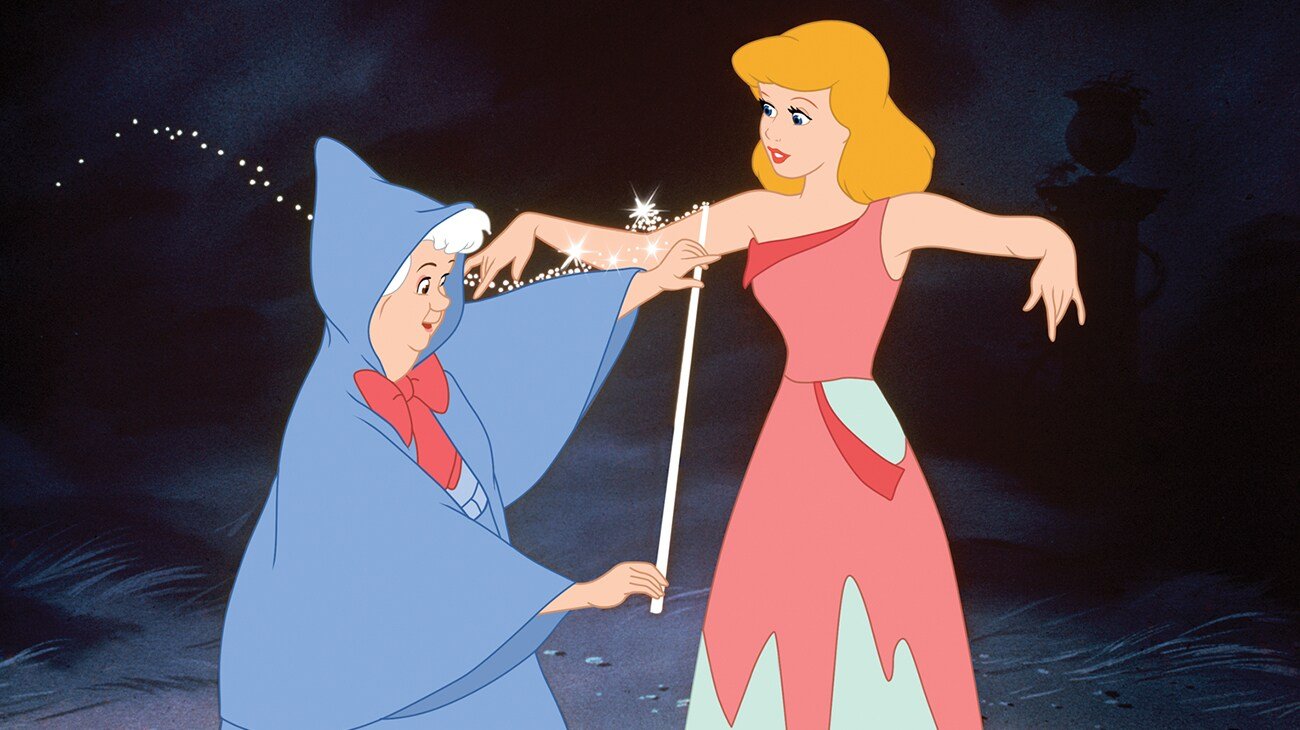Everyone knows the story of Cinderella—a timeless fairy tale that embodies the magic of kindness and dreams coming true. In this tale, a young girl endures a life of servitude under her cruel stepmother and stepsisters. One day, an invitation arrives for a grand ball at the palace, where the prince is searching for a bride. Cinderella longs to attend, but her stepfamily forbids it. Thanks to a sprinkle of magic from her fairy godmother, she transforms into a stunning beauty, complete with a gorgeous gown, glass slippers, and a pumpkin turned into a carriage. At the ball, she captures the prince’s heart, but as midnight strikes, she must flee, leaving behind one of her glass slippers. Determined to find the mysterious girl, the prince sets out to locate the slipper’s owner. After a series of twists and turns, he arrives at Cinderella's home, and with a touch of magic, the slipper fits perfectly. They reunite and live happily ever after.
Fairy Godmother preparing to give Cinderella a new dress so she can go to the ball, from Disney’s classic movie in 1950.
© Walt Disney
Over the centuries, this beloved tale has taken on various forms across different cultures. From the ancient Greek version of Rhodopis in 7 BC to the Chinese tale of Ye Xian—where the fairy godmother is a magical fish—each retelling reflects its culture's values while retaining the essence of the original story.
The Beautiful Rhodope, in Love with Aesop; engraving by Francesco Bartolozzi, 1782, after the painting by Angelica Kauffman.
Illustration of the story of Ye Xian by Stehanie Pui Mun Law.
The Brothers Grimm published their version, titled Aschenputtel, in 1812, which introduced darker elements, such as the stepsisters mutilating their feet to fit into the slipper and facing brutal punishment from birds.
European Folk and Fairy Tales illustrated by John D. Batten.
When After the Ball, a painting depicting Cinderella’s hurried exit from the ball with a lost glass slipper left on the staircase, arrived at The Center, we knew it deserved a fairytale ending. Our client shared that it is the centerpiece of a “polyptych,” a series illustrating the entire story. These paintings were originally discovered by a family member in an antique market in Milan, where they were believed to be of French origin. Our conservators were eager to work their magic and restore this vital piece of Cinderella’s story.
The painting prior to treatment.
The reverse of the painting prior to treatment.
The stretcher appeared to have been replaced and did not fit properly in the frame, and there was paper tape around the edges with wood additions nailed into the right and left sides. The painting was executed on a finely woven, lightweight linen canvas, with a dent to the right of the center and a small puncture in the lower right quadrant. There were seven patches and tape on the back of the canvas. The painting had a large complex tear. Age-related craquelure was present throughout, but it appeared to be stable. A previous repair to the right of the figure’s arm had developed a lumpy appearance over time, as had an area within the figure that had been previously repaired, filled, and repainted. There were three diagonal scratches located in the lower left quadrant. The painting was varnished with a glossy natural resin varnish that had discolored, exhibiting a layer of surface grime.
The complex tear.
The frame, made of wood, gesso, black bole, and gold-toned silver leaf, showed moderate losses of gesso and gilding at the miters and edges, with severe tarnishing throughout the silver leaf. Areas of bronze powder restorations were present along the upper edge, and the frame was covered in a layer of surface grime.
Whitney Houston as Fairy Godmother and Brandy as Cinderella in 1997’s musical rendition of Cinderella.
© Walt Disney
This time, instead of Whitney Houston, Cinderella’s fairy godmothers took the form of Michael Young, senior paintings conservator, and Josh McCauley, senior conservator of objects and frames.
Michael consolidated the flaking paint using conservation adhesives, and the canvas deformations were flattened as best as possible through a combination of heat, suction, humidity, and weight techniques. The surface of the painting was cleaned to remove grime while the reverse was cleaned with a soft brush and vacuum. The varnish layer and previous repaint were removed to the extent safely possible with appropriate solvents. Patches and adhesive residue were removed, and the tears were aligned and mended and reinforced on the reverse. The stretcher was keyed out to provide adequate tension for the canvas. Losses were filled and textured with conservation-grade fill material, and a coat of varnish was applied to saturate the paint layer. Inpainting was carried out in areas of loss and abrasion using reversible conservation paints, and a final coat of varnish was applied to integrate the surface gloss.
The painting under ultraviolet light during treatment.
Meanwhile, in our frames and gilding laboratory, Josh stabilized and closed the miters of the frame. The gesso and gilding were consolidated using adhesive, and the frame was cleaned with solvents. Scratches and abrasions extending through to the gesso layer were inpainted to emulate the surrounding surface as closely as possible. Large areas of loss were filled and ingilded to match, and the restorations were patinated. Aside from these restorations, the finish was left in its present state. The piece was assembled with a new fillet to achieve a better fit for the painting. It was reinstalled into the existing frame and an archival backing board was attached to the reverse for additional protection.
The painting after treatment.
The reverse of the painting after treatment.
The story of Cinderella transcends time and geography, with an endless catalogue of iterations and retellings throughout history. We were honored to give After the Ball a sprinkle of well-deserved magic so that it can continue to be treasured for generations to come.














